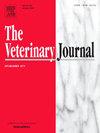淡水鳄鱼siamensis静脉注射和肌肉注射美洛昔康的药代动力学评价
IF 3.1
2区 农林科学
Q1 VETERINARY SCIENCES
引用次数: 0
摘要
美洛昔康(MLX)的药代动力学在爬行动物,特别是在暹罗鳄(Crocodylus siamensis)中仍未被广泛研究。本研究描述了在暹罗鳄鱼体内静脉注射(IV)和肌肉注射(IM)后MLX的药代动力学特征。根据平行研究设计,采用随机化程序将15只暹罗鳄分为三组(n=5)。MLX以0.2 mg/kg体重静脉注射或以两种不同剂量注射(0.2 mg/kg体重或0.4 mg/kg体重)。采用高效液相色谱法和紫外检测法测定MLX的血浆浓度。采用非室室模型分析药代动力学参数。各给药途径的消除半衰期(t1/2λz)均较长,分别为132.34 hr (IV)、121.35 hr (IM 0.2 mg/kg b.w)和181.44 hr (IM 0.4 mg/kg b.w)。静脉给药后的分布体积(Vd)和清除率(Cl)分别为104.59 mL/kg和0.55 mL/hr/kg。基于这些结果,这种淡水鳄鱼的MLX有一个扩展的t1/2λz,突出了与其他爬行动物和非爬行动物相比,药物倾向的显著差异。研究结果有助于了解该动物物种的MLX药代动力学,并强调MLX最佳剂量的选择应基于处置动力学、有效性、安全性和物种特异性差异。需要进一步的研究来确定有效的血浆浓度,这对于确定治疗疼痛和炎症的适当剂量至关重要。本文章由计算机程序翻译,如有差异,请以英文原文为准。
Pharmacokinetic evaluation of meloxicam following intravenous and intramuscular administration in Crocodylus siamensis, a freshwater crocodile
The pharmacokinetics of meloxicam (MLX) remain largely unexplored in reptiles, particularly in Siamese crocodiles (Crocodylus siamensis). This study characterized the pharmacokinetic profiles of MLX following intravenous (IV) and intramuscular (IM) administration in Siamese crocodiles. Fifteen Siamese crocodiles were divided into three groups (n=5) using a randomization procedure according to a parallel study design. MLX was administered IV at 0.2 mg/kg b.w. or IM at two different doses (0.2 mg/kg b.w. or 0.4 mg/kg b.w.). Plasma concentrations of MLX were measured using a validated high-performance liquid chromatography method with UV detection. The pharmacokinetic parameters were analyzed using a non-compartment model. The elimination half-life (t1/2λz) was long for all administration routes, with values of 132.34 hr (IV), 121.35 hr (IM 0.2 mg/kg b.w.), and 181.44 hr (IM 0.4 mg/kg b.w.). The volumes of distribution (Vd) and clearance (Cl) after IV administration were 104.59 mL/kg and 0.55 mL/hr/kg, respectively. Based on these results, there was an extended t1/2λz of MLX in this species of freshwater crocodiles, highlighting significant differences in drug disposition compared to other reptilian and non-reptilian species. The findings contribute to an understanding of MLX pharmacokinetics in this animal species, and emphasize that the selection of the optimal dose of MLX should be considered based on disposition kinetics, efficacy, safety, and species-specific differences. Further investigation is required to identify the effective plasma concentration, which is critical for establishing the appropriate dose for the management of pain and inflammation.
求助全文
通过发布文献求助,成功后即可免费获取论文全文。
去求助
来源期刊

Veterinary journal
农林科学-兽医学
CiteScore
4.10
自引率
4.50%
发文量
79
审稿时长
40 days
期刊介绍:
The Veterinary Journal (established 1875) publishes worldwide contributions on all aspects of veterinary science and its related subjects. It provides regular book reviews and a short communications section. The journal regularly commissions topical reviews and commentaries on features of major importance. Research areas include infectious diseases, applied biochemistry, parasitology, endocrinology, microbiology, immunology, pathology, pharmacology, physiology, molecular biology, immunogenetics, surgery, ophthalmology, dermatology and oncology.
 求助内容:
求助内容: 应助结果提醒方式:
应助结果提醒方式:


